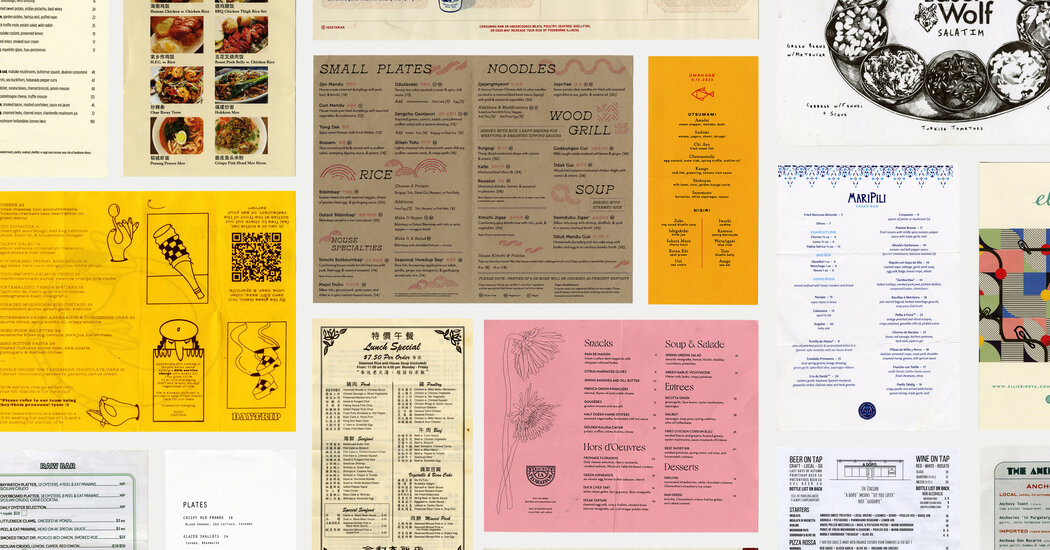Tanya Sichynsky likes to collect restaurant menus, and she even has a few of them framed on the walls of her apartment in New York. The menus she displays represent a few of the dinners she had during meaningful moments in her life.
Priya Krishna wrote about menus as a French major in college. For her thesis on cuisine and French culture, she analyzed menus from the banquets held by King Louis XIV.
Both women, editors on The New York Times Food and Cooking team, know there is more on a menu than the food and its price.
“That’s your first point of contact with the ideas or values that a restaurant might have,” Ms. Sichynsky said.
Ms. Sichynsky, Ms. Krishna and Umi Syam, a graphics editor at The Times, were behind a project on restaurant menus that was published last week. By examining more than 100 menus collected from restaurants across the United States, they deciphered some of the trends shaping the dining industry right now. The presentation includes digital scans of dozens of menus, allowing readers to see for themselves the colors, logos and phrases restaurants use to communicate with diners.
Here’s how the project progressed from idea to publication.
Developing Your Recipe
To choose their 2023 list of the 50 best restaurants in America, Food reporters and editors planned to survey dining scenes in different states. It would be a huge reporting effort, with enough legwork to inspire more than one article. Ms. Sichynsky, brainstorming ideas with Ms. Krishna, suggested they had an opportunity to study menus at large. Soon, the team had a directive: While sampling the fare at taverns, bistros and fry shacks for the 2023 national restaurant list, try to take the menus home with you.
“I find them so illustrative of an era,” Ms. Krishna said in an interview. “Unlike books, they’re not meant to be records in time. They’re not self-conscious. They tell it like it is.”
Preparing the Kitchen
By October, after the restaurant list came out, members of the Food and Cooking team had collected most of the 121 menus from American restaurants they would eventually gather.
“We didn’t really have an idea of what we were looking for at the time,” Ms. Sichynsky said. “It was kind of just like, what could those menus say about dining? What would they all have in common?”
In a conference room, Ms. Sichynsky and Ms. Krishna pored over the details, looking for themes.
They noticed dishes and ingredients. Crudos were a common offering. Yuzu, a citrus fruit from East Asia, was surprising in its ubiquity. Generally, they detected a more approachable, less-stilted tone of voice, even from high-end restaurants.
And clearly, the menus showed, the dining industry was wrestling with changing ideas around labor and compensation. To pay its workers fairly, more restaurants are now relying on fixed service charges — sometimes more than 20 percent of the bill — instead of or in addition to customer tips. Nearly one in five menus The Times gathered had language that explained a service charge policy, and the percentages varied.
“There was everything from calling it a service charge to calling it a kitchen appreciation fee,” Ms. Sichynsky said, adding: “There’s no standard right now.”
Setting the Table With Design
After Ms. Sichynsky and Ms. Krishna entered the restaurants and the trends they saw into a digital spreadsheet, they homed in on the themes they wanted to build their article around: food, aesthetic and menu structure. Within each category, they listed the changes (such as reducing the font sizes, or grouping dishes under labels like “bigger” instead of “entree”) and how they fit into the evolving ways we go out to eat.
With the help of The Times’s photo lab, a small group that specializes in image scanning, the Food team was able to import each menu as a photograph into the photo system. Ms. Syam then designed an interactive display that allowed readers to view menus by clicking on them and used clippings to highlight examples of the language embraced by restaurants.
“I thought about doing it multiple ways: fancy, scrolly, making things pop up. But in my experience, I realized that readers just wanted to explore the menus without fancy animations,” Ms. Syam said.
Ms. Sichynsky still has the stack of 121 menus. She has another use for them in mind.
“I think some of them are stunning, and I would love to turn a couple of them into a gallery wall,” she said.







